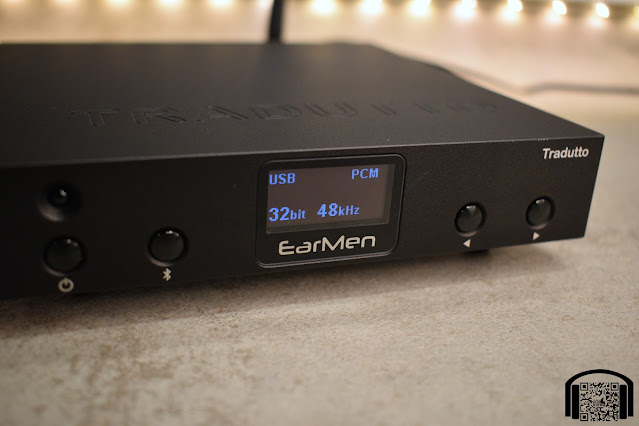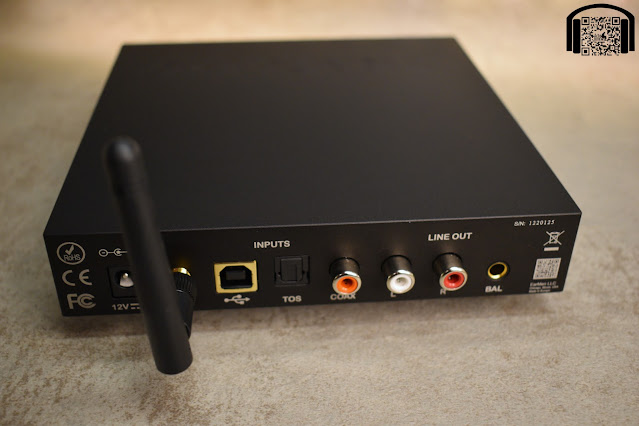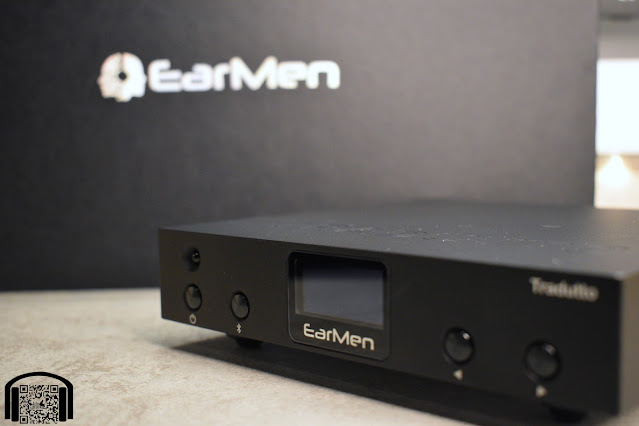- Get link
- X
- Other Apps
English | Español
TLDR version on YouTube: TDLR - Earmen Tradutto
The Tradutto has been sent to me directly by Earmen for me to share my findings and opinions in this review. There have been no requests (not even a time limit) from Earmen and, as always, I will do my best to be as sincere and unbiased as humanly possible.
The official page for the Tradutto can be found here: https://earmen.com/index.php/products/earmen-tradutto
As with all links that I share, this is a non-affiliate link, meaning that I do not receive anything for clicks or purchases made through this (or any other) link.
To avoid being repetetive in my reviews, you can find all the info about how I create the reviews, equipment used, how I receive the products and how to interpret my reviews by visiting: About my reviews
Intro…
Earmen is a company that I have been curious about for quite some time but I didn’t get my ears on any of their products until a few months ago in Munich. At high end, Earmen actually had two stands, one with their products along with their products also being on show at their parent company's stand, Auris audio.
In show conditions it is very difficult to judge the sound of speakers or headphones (unless there is a very good listening room set up and you are lucky to find it empty), so trying to get a feel for DAC’s or Amps is almost impossible. Therefore, when Earmen said they would send me the Tradutto to incorporate it into my own system and review it, I was very happy to do so.
The Tradutto is a pure DAC, meaning there is no built in amplifier, nor is there a volume control, nor is there much else, but I’ll get to that under functionality in just a moment. Basically it does one job, takes digital signals and transforms them to analog, and it does that job very well.
I have actually been trying out the Tradutto during a time when things have been a little hectic for me and my review set up. I recently picked up some studio space, with the intention of moving all of my test set ups to the studio and being able to test and create my reviews there (as my house seems to have more space occupied by Acho Reviews than my family lately!). Unfortunately the setting up and moving to the studio is taking much longer than expected due to lot’s of other things going on, along with the fact that it’s summer, so who wants to spend time locked in a room setting up stuff rather than spending time in the pool?!
However, due to the hectic nature of me having things everywhere at the moment, it has meant that I have been able to incorporate the Tradutto into various systems that I problably wouldn’t have if I had just focused on my normal procedures. Basically I have had it hooked up to headphone rigs, main speaker rig, small speaker set ups and even a few loose systems that haven’t been used in quite some time. So, if one thing I am sure of, it is that I have tested the Tradutto in a huge amount of scenarios!
As usual with my DAC (and amp) reviews, I end up making them far too long and we haven’t even started talking about the device yet, so let’s get on with it.
Presentation…
After seeing the Tradutto in person and seeing how small it is, I was surprised at both the size and the weight of the box it appeared in. In a rather nice box with a lift up lid, surrounded with a cardboard sleeve showing the device and the specs, we find the device very well protected by multiple layers of foam and cardboard.
Inside we find the DAC, a nice little metal and rechargeable remote control, the bluetooth antenna, a fabric covered USB-A to USC-B cable, the power supply with interchangeable connections (so it will work not matter what country you are in), a micro fiber cloth and the user manual.
I have absolutely nothing negative to say about the presentation or the included contents. Of course a couple of interconnects would have been a nice addition, especially a 4.4mm to XLR as they are still not the easiest (or cheapest) or cables to source but we could always think of more things to include.
Build and Aesthetics…
The Tradutto is a small unit, basically a simple square box, with a small and simple screen on the front, along with 4 buttons. The aesthetics are something that seem to be more aimed at blending in than standing out and the small size does mean that you can fit it just about anywhere. Tradutto is engraved very nicely across the top of the device and is also shown in small white letters on the front panel. Personally I think that they could have skipped the model name on the front as I feel it takes away a little from the aesthetics but it is small and is certainly not shouty about it.
As with the box it came in, I was very surprised with just how much the DAC weighs. There is no issues with interconnect cables pulling the device around, as is the case with some other small units, it will sit where you put it. It also has feet that elevate it off of the surface, with the cooling vents underneath, allowing you to put the Tradutto wherever you prefer without having to worry too much about keeping it cool (you can tell the device is on by touching it but by no means does it get hot, or even warm).
The screen is nothing fancy, just a simple OLED screen that shows the selected input, file format, bit rate and frequency rate when fed by USB, in other modes it shows the selected input. There are no flashy colours but the important info is there at a simple glance and I am glad to say that it is not overly bright, even in a dark room it is easy on the eyes.
While the aesthetics are nothing special, I have no issue with them and I think that it looks quite good with the matching CH-Amp (the amplifier from Earmen) sitting on top, resulting in a simple small stack that doesn’t look out of place but will never be the center of attention.
Speaking of the CH-Amp, the remote included with the Tradutto has two sets of buttons, the top set to control the CH-Amp and the lower set to control the Tradutto. This is nice if you have the stack but is obviously redundant if you don’t. The remote itself is nicely built, small and compact, and features a USB-C port on the bottom to recharge the remote control and not have to worry about batteries, which is another nice touch.
In general, everything is well built and the aesthetics are something that I haven’t received any complaints about no matter where I have placed the Tradutto, even dead center under the TV in the living room 😉
Functionality…
The Tradutto is a very simple, no frills, DAC. There is no volume control, no filter selection, no menus, no anything except for input selection and power. If you are looking for something to spend hours tweaking settings, then you can look elsewhere. The Tradutto focuses on taking your choice of digital input and giving you a choice of balanced or single ended analog output.
On the back of the device we have, from left to right, the following:
- Power supply (12VDC)
- Bluetooth Antenna
- USB input
- Optical input
- Coaxial input
- RCA unbalanced outputs
- 4.4mm balanced output.
Moving around to the front, again from left to right, we get:
- IR receiver (top left)
- Power button
- Bluetooth pairing button
- Screen
- Input selection left
- Input selection right
That is it, a simple selection of 4 buttons that have one single function each, which are also replicated on the remote control (although left and right are labelled + and - on the remote).
I don’t think that there is much need to explain how this works, you plug in cables, turn it on, select your input and enjoy. The left and right buttons (or +/- on the remote) cycle through the inputs (USB/TOS/COAX/BT), yet when you reach the end, you will need to use the other button to cycle back the other way (there is no loop).
When I first hooked up the Tradutto to my PC (windows 10), it worked straight away with the usual windows audio mixer, however, in order to use WASAPI from Foobar, I did need to upgrade the firmware. The firmware is available on the Earmen site and comes with instructions, which are very straight forwards, and takes around 30 seconds.
Sound…
As I said in the intro, I am currently moving a lot of stuff about, setting up the studio and redesigning my main listening setups at home, which means I also have a lot of equipment that is usually in storage. This allowed me to try the Tradutto in a lot of scenarios and I have to say that there wasn’t a one where I disliked the outcome.
In general, I would say that the Tradutto has a very detailed yet smooth signature. I know that this is my brain telling me that this is what I am hearing, maybe because I want to hear it, but the feeling that the Tradutto just works well with everything is the impression I have been left with.
Paired with things like the Schiit Asgard 3, I didn’t find the result to be overly warm, just nicely detailed and smooth. It is sort of a dialed back "iFi sound", with a hint of warmth and smoothness but never overly done. The same can be said with the Feliks Audio Echo MK2, where too much warmth can be detrimental, especially if using overly warm headphones, yet I didn’t get that sensation. I used the HD6XX and the Echo fed from 3 different DACs (the three way input selection on the Echo is great by the way!) and I didn’t find that anything was glossed over when selecting the Tradutto. In fact, it is very reminiscent of the R2R Dac in the EF400 as far as presentation with the Echo, yet I get the impression that the details are easier to identify but still not “in your face” as with some other more clinical offerings.
I hooked it up to the THX789, which is an amplifier that I don’t really use for listening to music very often but find it is still very good to evaluate sources (not just DACs but also the tracks themselves) as it’s cold and abrupt presentation quickly highlights any digital and/or harsh factors. With the Tradutto I didn’t find any of these, the presentation was obviously cooler and less smooth than on the other options I just listed, but it was still nice and smooth. In fact, it is possibly the most I have enjoyed listening to the 789 for quite some time.
Something that I did find positive was that there seems to be no difference in the output of the balanced and unbalanced connectors, apart from voltage that is. I have come to realize that, while most of my speaker setups are balanced, for headphones I have gravitated more towards unbalanced, so it is nice to not get the feeling that one output underperforms the other.
I also got a chance to hook the Earmen up to a set of Meyer Sound UPM-1P, a set of speakers that I am very fond of and are very revealing. The only issue was that I needed to control the volume before the DAC due to the Tradutto not having preamp capabilities (no volume control) and the speakers being active. Therefore I fed the Tradutto via coax digital from my DSP and controlled the volume level there. I have to say that the result was nothing short of great. It may be in my mind but I feel that the UPM-1's performed much better than directly from my DSP and the sound was not only detailed but also more musical. I would happily listen to the set up for… well, permanently 😀
With other less revealing speaker set ups, the pairing still performed well, without things getting bloated or overly smoothed (not more than the usual with said speakers of course) and with studio monitors, I found that detail was excellent while still sounding a little less clinical than with other DACs that I use in those situations normally.
Conclusion…
As I always say, the mind is a very powerful thing (for most people at least) and is capable of filling in blanks and adding twists to things that may be dependent on us wanting to like something. While that may be the case here also, I am happy with the result!
I am sure there are reasons that I could come up with to not purchase the Tradutto, as with anything, but I honestly feel that the sound performance is not one of them. I have been enjoying this DAC in all the situations I have put it in and my biggest issue is that, if I hook it up to my speakers, I then want to hook it up to my headphone rigs and vice versa.
There are other alternatives out there at lower price points which perform very well, maybe even better, and there are others at much higher price points that perform better (or maybe worse in some cases), but if we disregard price and aesthetics (which are of course very personal and very important to some), as far as performance, I really can’t find a thing to complain about with the Earmen Tradutto.







